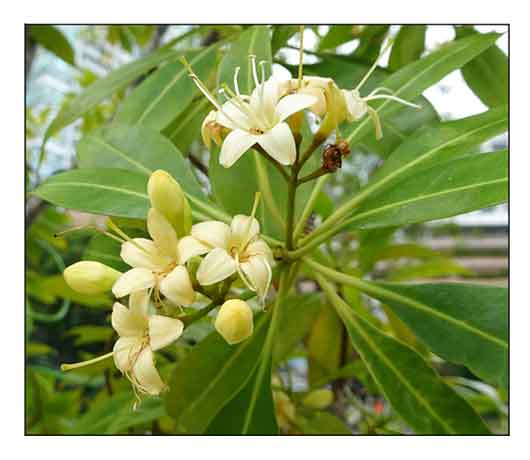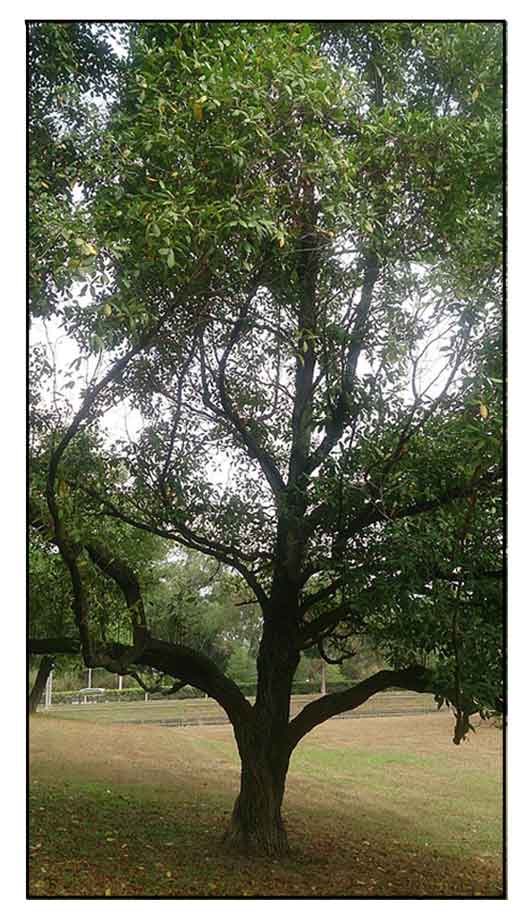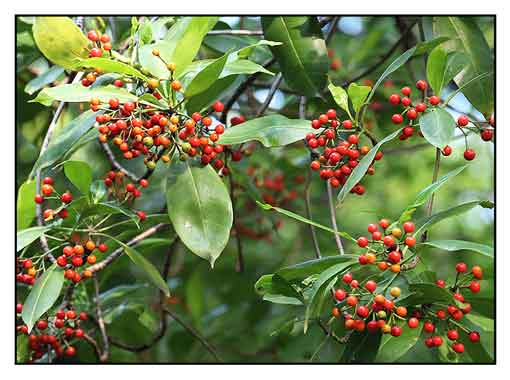 Gen info Gen info
- Cyrtophyllum is a genus of tropical Asian tree species i the family Gentianaceae and the tribe of Potalieae. Species were previously placed in the genus Fagraea.
Plants of the World Online currently lists five species: C. caudatum, C. fragrans, C. giganteum, C. lancelatum, C. minutiflorum. (2)
- In Thailand, it is the provincial tree of Surin Province and the university tree of Ubonratchathani.
It is pictured on the Singaporean five-dollar bill. (4)
- Etymology: The genus name Fagraea honors the Swedish naturalist Jonas Theodor Fagraeus (1729-1797). The species epithet fragrans is Latin, meaning perfumed or fragrant, referring to the flowers. (10)
 Botany Botany
Cyrtophyllum fragrans is a tree up to 30 m tall, growing irregularly shaped, with deeply fissured dark bark, and with buttress roots up to 2.5 m tall. Branches are distinctive, extending outwards and upwards like fingers. Leaves are opposite, oval-shaped, light green; stalked leaves have thinly leathery to leathery leaf blades that are usually elliptic, distinctly tipped, and 5–13 by 2–5.5 cm.. Flowers are bisexual in 4–12 cm wide flowering clusters (inflorescence) that develop at the leaf axils; cream-white turning yellow, fragrant, and about 2 cm across. Fruits are orange or red, broadly ellipsoid, bitter tasting, containing numerous tiny seeds of less than 1 mm. (5)
Fagraea fragrans is a medium-sized or occasionally large tree up to 25(-55) m tall. Bole measures up to 135(-250) cm in diameter, occasionally fluted or with buttresses up to 2.5 m high. Bark surface is deeply irregularly fissured and dark brown while the inner bark is brown to yellow. Leaves are oblong-Iance-shaped to obovate-oblong, measuring 4-15 cm x 1.5-6 cm and usually with short to long, broadly acuminate apex; secondary veins are slightly prominent to indistinct below, 1-2.5 cm long petiole while the stipules are rounded and partly free from the petiole. Inflorescence is axillary while the pedicel and bracteoles are at or below the middle. Flowers are fragrant, with narrowly funnel-shaped petal tube, measuring 0.7-2.3 cm long, with headed stigma and faintly 2-lobed. Fruit is 0.7-1 cm long, broadly ellipsoid and orange or red. (GLOBinMED) (8)
Distribution
- Native to the Philippines.
- Grows primarily in the wet tropical biome.
- Also native to Andaman Is., Borneo, Cambodia, Jawa, Laos, Malaya, Maluku, Myanmar, New Guinea, Sulawesi, Sumatera, Thailand, Vietnam.
(1)
 Constituents Constituents
- GC-MS study of essential oil of flowers identified 118 volatile constituents, dominated by 3-octadecyne, catalponone, and elemicin. A dichloromethane extract of flowers yielded ß-bisabolenol, occidol, and eugenol as major constituents. A hexane extract showed 3-octadecyne, catalponone, and sempervirol as major components while the methanol extract yielded grandiflorene, himachalol and occidol as dominant components. (see study below) (7)
- Study isolated a dimeric pyridine alkaloid, oliveramine, from diethyl ether extracts
from Fagraea fragrans barks. (9)
- Study of stem bark of Fagraea fragrans isolated seven new compounds constituted by three secoiridoids (1–3), two isocoumarins (4 and 5), an iridoid (6), and an aromatic derivative (7) in addition to 24 known compounds. (see study below) (12)
- Study of roots and flowers isolated a new secoiridoid glycoside, 3'-O-p-trans-coumaroylsweroside (1), together with 29 compounds (2-30). (see study below) (13)
- Study of methanol crude extract from stem bark isolated 14 compounds: Benzoic acid, E-stilbene, 4-hydroxy-3,5-dimethylbenzealdehyde, 4-hydroxy-3,5-dimethoxybenzaldehyde, 4-hydroxy-3,5-dimethoxybenzyl alcohol, 4-hydroxy-2-methoxycinnamaldehyde, 4-hydroxy-3,5-dimethoxycinnamaldehyde, palmitic acid, methyl 9,12-octadecadienoate, linoleic acid, stearic acid, stigmastan-3,5,22-triene, stigmasterol, and ß-sitosterol.
(14)
- Study of fruits identified three alkaloids: gentialutine, gentianine, and isaindigotone.
(15)
- Study of crude methylene chloride extract from stem bark yielded four aromatic derivatives, (2E)-nonacosyl ester (1), cinnamaldehyde (2), vanillin (3) and syringaldehyde (4).
(19)
- Study of bark and leaves of F. fragrans isolated a secoiridoid aglycone, fagraldehyde (1), together with several known secoiridoids, gentiopicroside (2), sweroside (3), and swertiamarin (4). (see study below)
(20)
- Study of stem bark isolated a new lignan, fagraenolide (1), along with 14 known compounds. ß-boswelic acid (4), gentiogenl (5), 3-(4-hydroxy-3-methoxyphenyl)-acrylic acid octacosyl ester (7) and pinoresinol (14) were isolated from the plant for the first time.
(21)
Properties
- Studies have suggested antibacterial, antioxidant, antimycobacterial, anticancer, antiplasmodial properties.
Parts used
Bark, leaves, roots.
Uses
Edibility
- Fruits are bitter tasting, eaten by Pteropus fruit bats.
Folkloric
- Decoction of bark used as febrifuge in malaria.
- Decoction of twigs and leaves used to control dysentery and severe diarrhea.
- The Kadazan treat pancreatitis and gastric pains by applying pounded leaves and bark over the lesion and drinking the decoction at the same time. Bark used for treatment of jaundice. Decoction of bark used in neonatal jaundice. Decoction of leaves, bark, or root used for treatment of malaria. Decoction of F. fragrans together with roots of Amaranthus sp. used to ease menstrual flow. Decoction of bark used as febrifuge. (8)
- The Daya people of South Sumatra use leaves of Cystophyllum fragrans to treat diabetes mellitus.
(11)
- Used in treatment of malaria, asthma, cough, breathing difficulties, anemia, hemorrhoids.
Others
- Wood: Main source of tembusu timber. Heartwood is light yellowish brown. Wood is medium weight, very hard and durable, and can last over a hundred years; resistant to termites and weevils. Used to make chopping boards, flooring, posts and piles, railway sleepers, barrels, furnitures, doors, and wood carvings. Yields first-class turnery timber. (4)
- Fuel: Provides high quality fuel wood and charcoal.
- Latex: Latex under the skin of fruits used as adhesive.
Studies
• Antibacterial / Antioxidant / Essential Oil / Flowers: Study evaluated the essential oil of flowers for phytoconstituents and antibacterial activity. The essential oil showed to be a remarkable bactericide. Dichloromethane, hexane, and methanol extracts showed MICs ranging from 125 to 1000 µg/ml against gram-positive and gram-negative bacteria. The EO also showed superior antioxidant activity (IC50 of 35.32 µg/ml) compared to extracts (IC50s 72.69-154.99 µg/ml) by DPPH radical scavenging assay. (see constituents above) (7)
• From Fagraea to Cystophyllum: A molecular phylogenetic study reported that Cystophyllum Reinw., one of several distinct lineages among the Fagraea complex, is the correct genus to which fives species of South East Asian trees should be assigned, including widespread F. fragrans. (6)
• Antimycobacterial / Combination with Erythromycin / Stem Bark: Study of stem bark isolated seven new compounds: three secoiridoids, two isocoumarins, an iridoid, and an aromatic derivative in addition to 24 known compounds. 5-Formylisochromen-1-one (4), (-)-mellein (8), and swermacrolactone C (9) exhibited potent antimycobacterial activities against Mycobacterium smegmatis when combined with antibiotic erythromycin. (12)
• Anticancer / Roots and Flowers: Study of roots and flowers isolated a new secoiridoid glycoside, 3'-O-p-trans-coumaroylsweroside (1), together with 29 compounds (2-30). Compounds 2, 3, 6, 11, and 13-15 showed weak to moderate cytotoxicity against cholangiocarcinoma cancer cell lines (KU-213, KKU-055, and KKU-214). (13)
• Herbal Cosmetic Ingredients / Flowers: Study evaluated F. fragrans fruits as potential source of material for herbal cosmetic formulations. Study identified 3.1% ursolic acid and its isomeric oleanolic acid and a number of other compounds such as alkaloid, flavonoid, ginsenoside, and tannin-trimer as important bioactive cosmetic ingredient having potential benefits for skin and other body parts. (16)
• Derivatization of Ursolic Acid and Oleanolic Acids / Anticancer Activity / Fruits: Study sought to derivative the inseperable ethyl ursolate 3-ethyl ether and evaluate their anticancer activity against P-388 murine leukemia cells. Results are 71% of the derivatives have been successfully made from the inseperable ursolic acids by in situ reaction. The anticancer activity of ethyl ursolate 3-ethyl ether against P-388 murine leukemia cells showed IC50 of 31.36 µg/ml, which is twofold (1.7) more potent than mother compounds, the inseperable ursolic acids with IC50 of 53.5 µg/mL. (17)
• Cytotoxicity on MCF-7 Mammary Cancer Cell Lines: Study evaluated 21 extracts of Thai medicinal plants used in rejuvenating medicine for cytotoxic and estrogenic activity on MCF-7 mammary cancer cells. Fagraea fragrans exhibited lowest (0.00%) cell growth. (18)
• Fagraldehyde / Weak Antiplasmodial / Bark and Leaves: Study of bark and leaves isolated a secoiridoid aglycone, fagraldehyde (1), together with several known secoiridoids. Fagraldehyde was weakly active in vitro against Plasmodium falcifarum (see constituents above) (20)
• Antioxidant / Leaves: Study evaluated F. fragrans for phytoconstituents and antioxidant activity by DPPH assay. Results showed the active antioxidant fractions were n-hexane and ethyl acetate fractions. Antioxidant compounds isolated were terpenes (N1, N2, N4, E8), phenols (N5), and flavonoids (E11). Results showed antioxidant bioactive compounds in tembesu leaf have potential to be developed into standardized herbs and pharmaceuticals. (22)
• Anti-Inflammatory / Leaves: Study evaluated different fractions of F. fragrans for inhibition of Nitric Oxide (NO) overproduction on LPS-stimulated murine macrophages. The best anti-inflammatory potency (10 µg/ml=80% inhibition) was provided by a fraction from the leaf polar extract. (23)
Availability
Wild-crafted. |

![]()






